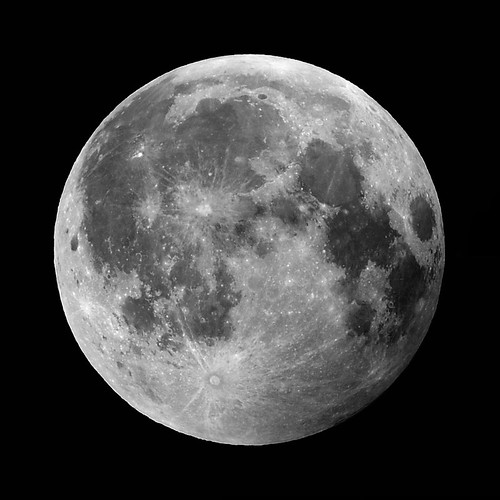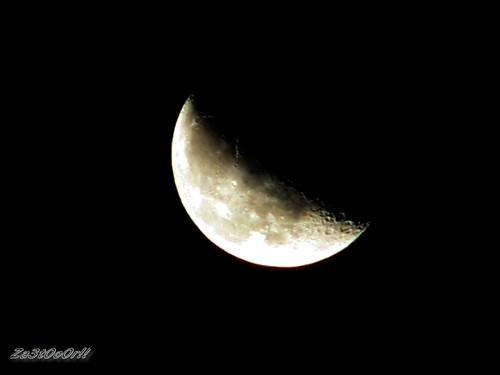Learning how to photograph the moon has long been one of the greatest joys of a photographer's journey in learning. For centuries the moon has captivated people, given direction and provided hours of enjoyment and wonderment. Being the brightest object in the night sky, it's something photographers of all levels can shoot, however it does take planning and preparation to accomplish.

The moon is bright, but it isn't bright enough to simply snap a photo if you're looking to see much detail in the moon. To achieve a nicely exposed photo, one where the moon doesn't appear flat nor like an out of place object, we need to consider this. To accomplish a great moon shot, let's first look at the basic gear you'll need.
Tripod. A secure base and workstation for your camera is essential to capturing the moon and avoiding camera shake. While you may be able to get away with hand holding your camera, your best results will, without a doubt, come from mounting your camera on a tripod. (See our article on how to choose a tripod for some good tips).
Long zoom lens. In order to help fill the frame and properly show off the moon, the longer your zoom lens the better. You don't necessarily need the fastest lens, because you'll be on a tripod, but it's best to use anything 200mm or longer. If you don't have a lens that long, you might want to consider using shorter lenses but incorporating foreground elements to the shot (more on that below).
Shutter release cable. Or a wireless remote if it's an option for your camera model. This is not an essential piece, but it's nice to have and helps avoid camera shake. If you don't have one you can cheat and use the self-timer function on your camera.
Camera. While almost any camera will work, point and shoots rarely produce top quality photos of the moon, mostly due to the small size of the sensor and it over-heating during longer exposures resulting in digital noise. A DSLR is preferred here with a long lens on it. Mirrorless cameras are also suitable. Camera with smaller sensors make it tough.
No preset or auto function of your camera will be able to properly meter the moon, so ideally you should consider shooting in full manual mode. At the very least, choose Aperture Priority mode. Also, your geographical location and current phase of the moon will have an effect on what your settings will be and you will need to adjust for the season of year and clarity of the sky.
ISO. Digital cameras should be set to 100 or lower, film shooters should shoot film of 100 ISO or slower to eliminate noise and grain.
Aperture. Because you're after crisp, clean shots, shooting at f/11 to f/16, depending on your lens, will be the best place to start. Research your lens' sweet spot to find the sharpest aperture.
Shutter speed. The variables are many and include those mentioned earlier, such as the phase the moon is in, geographical location and desired shot, but on a clear night starting at about 1/60th to 1/125th should be a great starting point.
A word about where you choose to shoot. Picking a spot to shoot the moon is one of the most important factors in achieving a quality shot.
Ideally, if you want to showcase the moon itself you will want to avoid any other ambient light, including street lights and traffic. This may require you to go off on a remote road or into a public park after hours – your backyard may not be the best location for these types of shots.
On the contrary, if you are trying to include a city skyline under your moon shot, you'll need to find a lookout that allows for the twinkling lights below and do further test shots to nail the exposure properly for both the foreground and the moon (bracket your exposures).
The Best Mobile Apps To Choose Location and Time for Photographing the Moon
Photopills is an excellent iOS app which can be used to determine the position and phase of the moon as well as the position and elevation of the Milky Way.
For Android users, an equally great photography planning app alternative is The Photographer's Ephemeris.
The composition is just as important when you are taking shots of the moon as for any other type of photography and you have some decisions to make. For starters, the decision to shoot just the moon or to incorporate elements such as landscape foreground into the shot. Knowing how to photograph the moon with foreground requires a few different concerns. Here are a few things to think about.
How to Photograph Just the Moon
- Use a long lens (> 200mm) and zoom in as far as you can
- ISO 100
- f/11 to f/16 (find the sweet spot for sharpness)
- Shutter speed around 1/60th to 1/125th
- Manual focus set to infinity
How to Photograph the Moon with Foreground
When you photograph the moon with foreground included, you will probably notice that you end up with the moon as a totally white blob with no detail. It is very difficult to expose both the foreground and the moon correctly in the same shot. For that reason, most of the photographs of the moon with a foreground that you see are actually composite images. There is a useful, if somewhat dated, tutorial on creating moon composites here.
- Use whichever lens allows you to get your composition (probably slightly wider)
- ISO 100
- f/11 to f/16
- Bracket exposures to +2 and -2 (this may take some experimentation)
- Create a composite of images in Photoshop.
Post-processing your photos is really straightforward and in most cases, an auto white balance will do you just fine, however, photographs of the moon also make stunning black and white images. So consider how you want the outcome to look – have a play around in Lightroom and see what looks best – color or black & white?
If you have photographed just the moon, when you import into Lightroom, you are probably going to want to concern yourself mainly with the contrast and clarity sliders. These should get you close to a finished product without too many problems.
If you have included elements of the foreground in your moon image, then you will probably have bracketed your shots and will, therefore, have some work to do in Photoshop. There is a good tutorial on creating composite images of your moon photographs here.
If you want to take it even further and print your moon photos, then you might like to look at our article on the best photo printer to use for the task!
- Play with composition aside from shooting the moon on its own
- Get low and shoot through the rising stalks in a cornfield (for example) and create a composite
- Catch the reflection of the moon in the ocean while on the beach
- For extra-sharp detail, wait until the moon is at its highest
- Use a tripod
- Use manual focus
- Use low ISO to avoid noise
- Research the sweet spot of your lens
- Allow time to set up – you don't want to be moving once the moon is in position to shoot
As inspiration, here are 10 great examples of moon photography!

A gorgeous Golden Color captured here with some impressive detail, despite only 3/4 of the moon actually showing. Wow! Photo by jurvetson on Flickr

Shooting with monochrome in mind can produce some beautiful results. A lovely finish here with tremendous detail – almost looks like fine art. I personally like the absolute central composition here, it works really well.Photo by penguinbush

Photo by Flowery *L*u*z*a* . Add some foreground elements to really enhance your composition. This bird creates an almost “spooky” night time feel.

Foreground elements again show some beautiful results, this time using the moon's bright reflection on the ocean. Rivers, lakes (even large puddles) could achieve alternative “reflection shots.” Photo by Kuzeytac.

Shooting through a field of crops creates a truly magnificent dimension, along with these dusk tones, make for a compelling image with some interesting detail – especially in the shapes and lines. Notice how the moon itself has been framed by the crops? Photo by joiseyshowaa.

Photo by kukkurovaca: Another black and white example, however, this time with a slightly different composition technique – this time, using some negative space and applying some techniques from the rule of thirds, makes the moon really stand out!

More foreground usage can be seen here, this time a cityscape shot of the moon. It's almost as if the moon and colorful lights are competing against each other for outstanding beauty! The long exposure has provided not only detail of the moon but a smoothe silkness to the water. Photo by Werner Kunz

A foreground element used again, however, this time it's in the form of a silhouette. This photograph of the moon shows it hiding from the viewer, creating a somewhat mysterious feel? Photo by makelessnoise

Lastly, we have a crescent shape captured here.
A dramatic shadow falls across the moon, which from a distance looks as though only half is ever present. Photo byZa3tOoOr!
Don't forget to check out our other collection of inspiring moon photos.
Light Stalking https://ift.tt/2vEJ082
Sourced by Time Trap Photography sharing the best photography tips, news and tricks throughout the industry. Time Trap Photography is dedicated to freezing those special moments in life that can be revisited and admired for generations to come. - Shannon Bourque
Please visit our main site for booking availability and rates.

Receive valuable industry knowledge delivered free to your email each day.







No comments:
Post a Comment
Thank you so much for your comment. A moderator will review and approve all relevant posts. We appreciate your support and encourage you to stay with us by subscribing to our email updates. Where you can easily pick and choose what photography subjects interests you. Subscription link: http://bit.ly/photo-sub